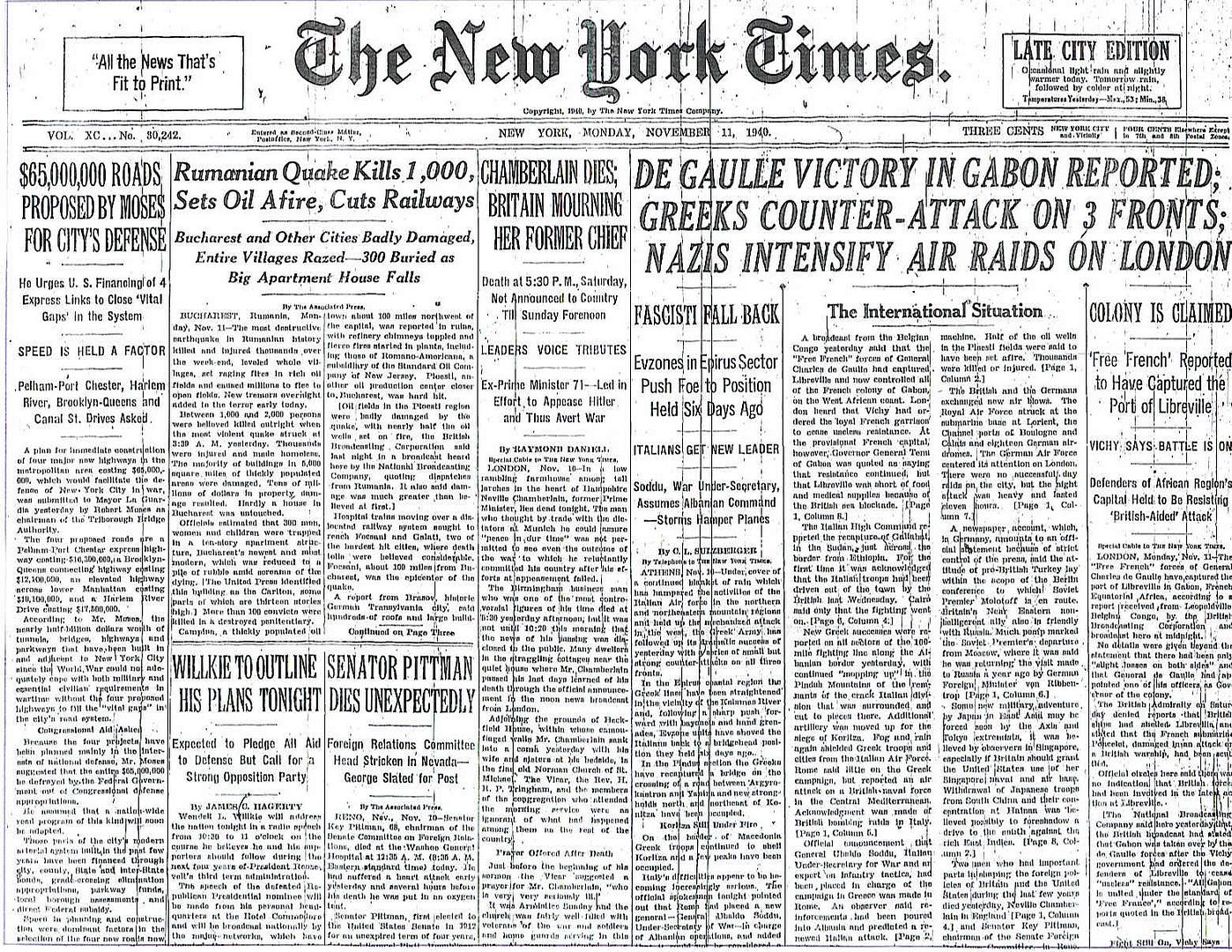
Posted on 11/11/2010 4:50:05 AM PST by Homer_J_Simpson

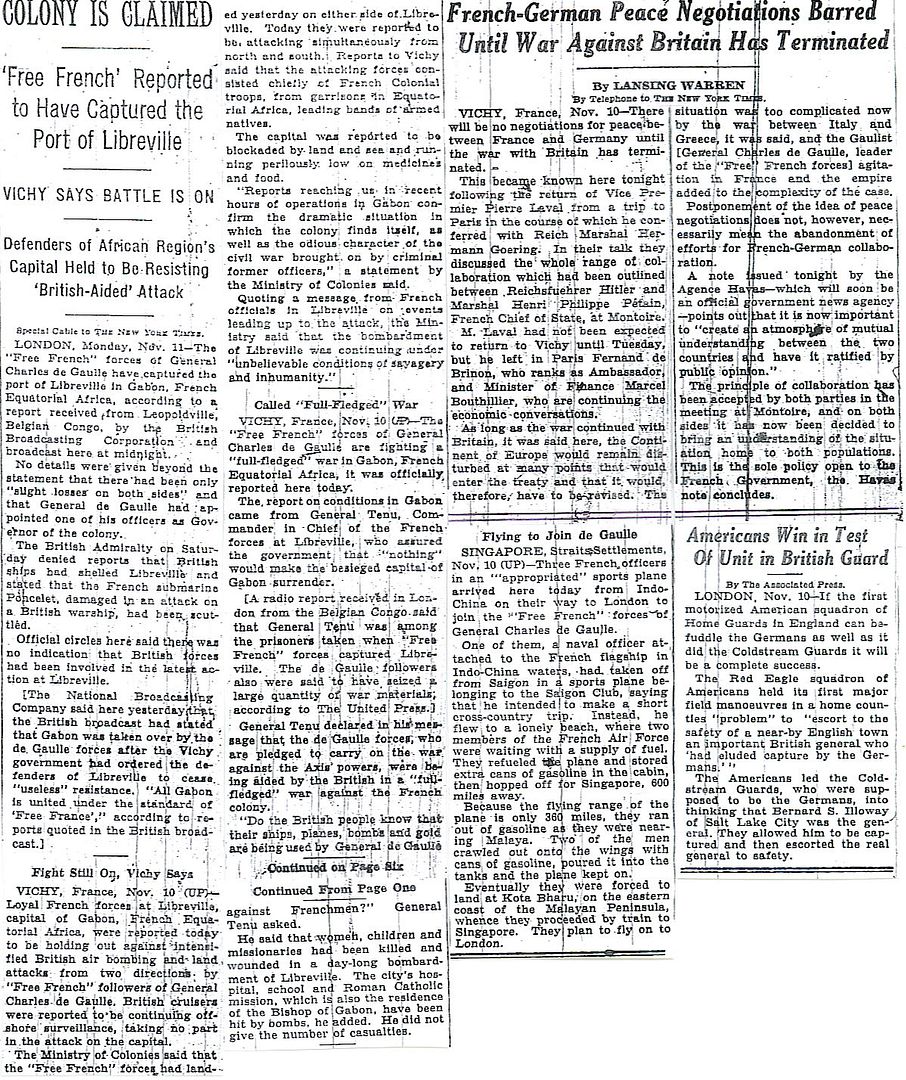
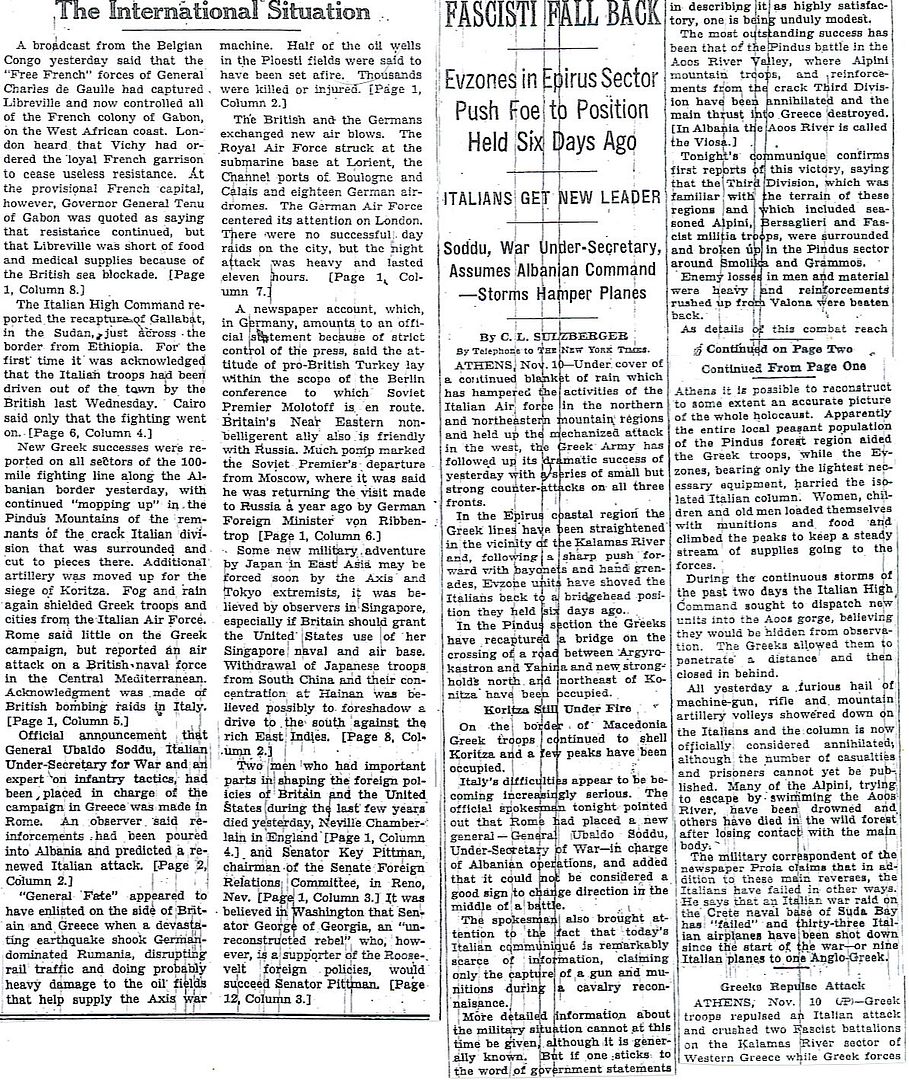
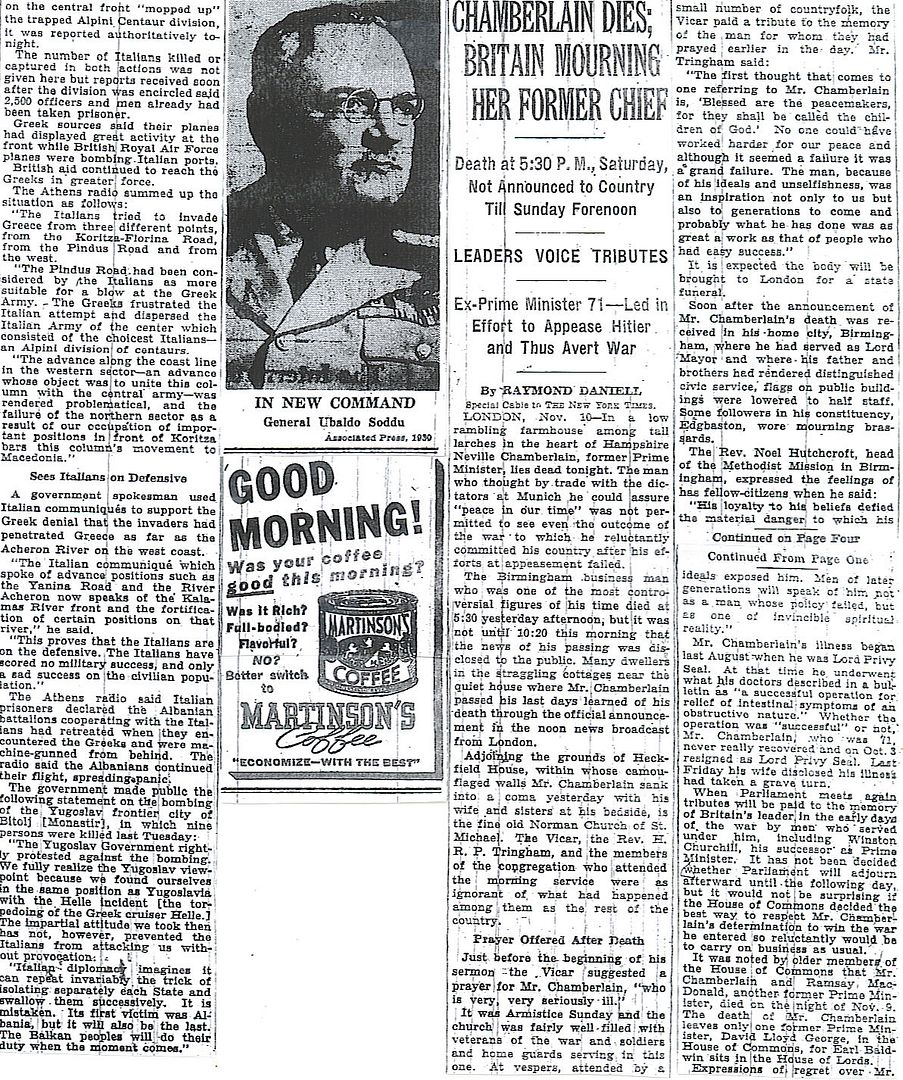
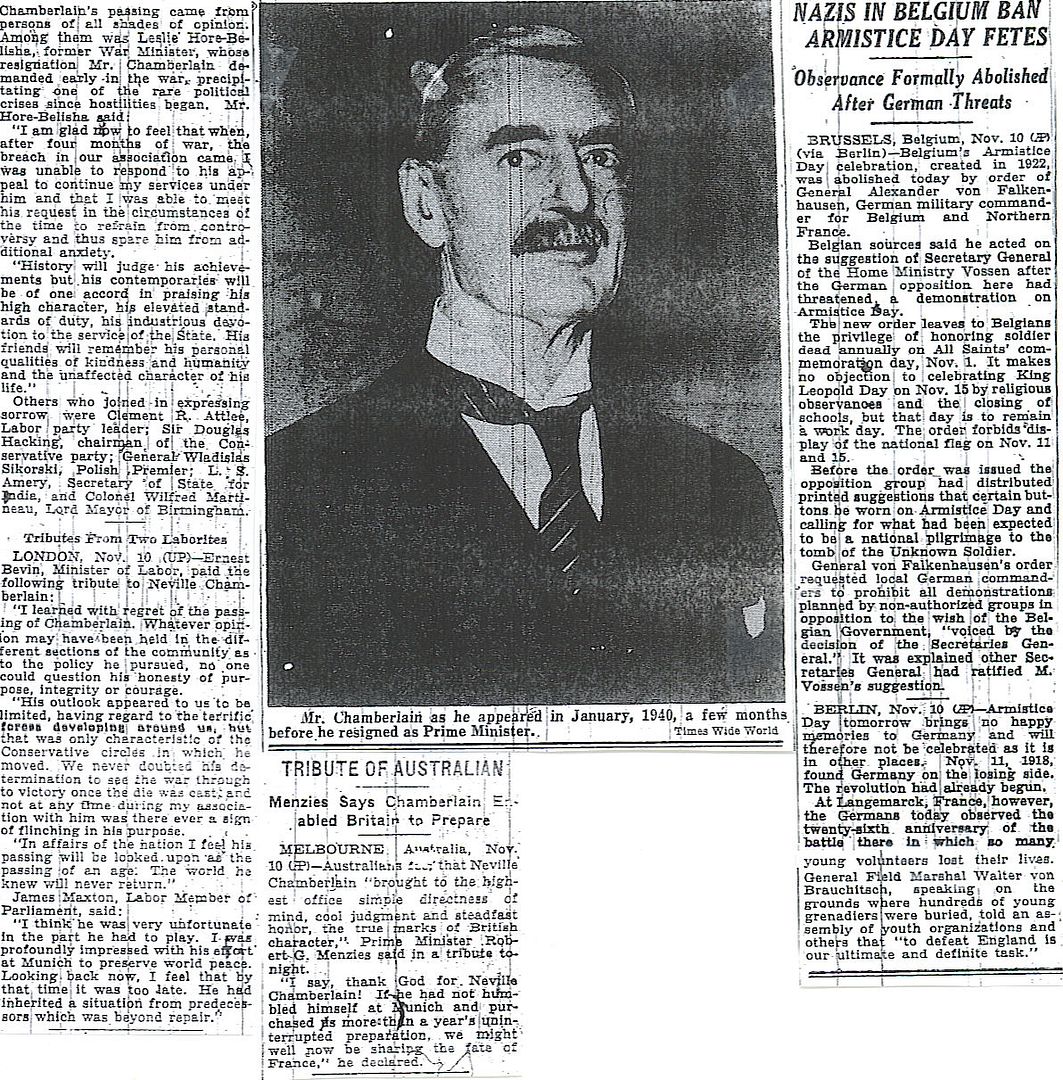
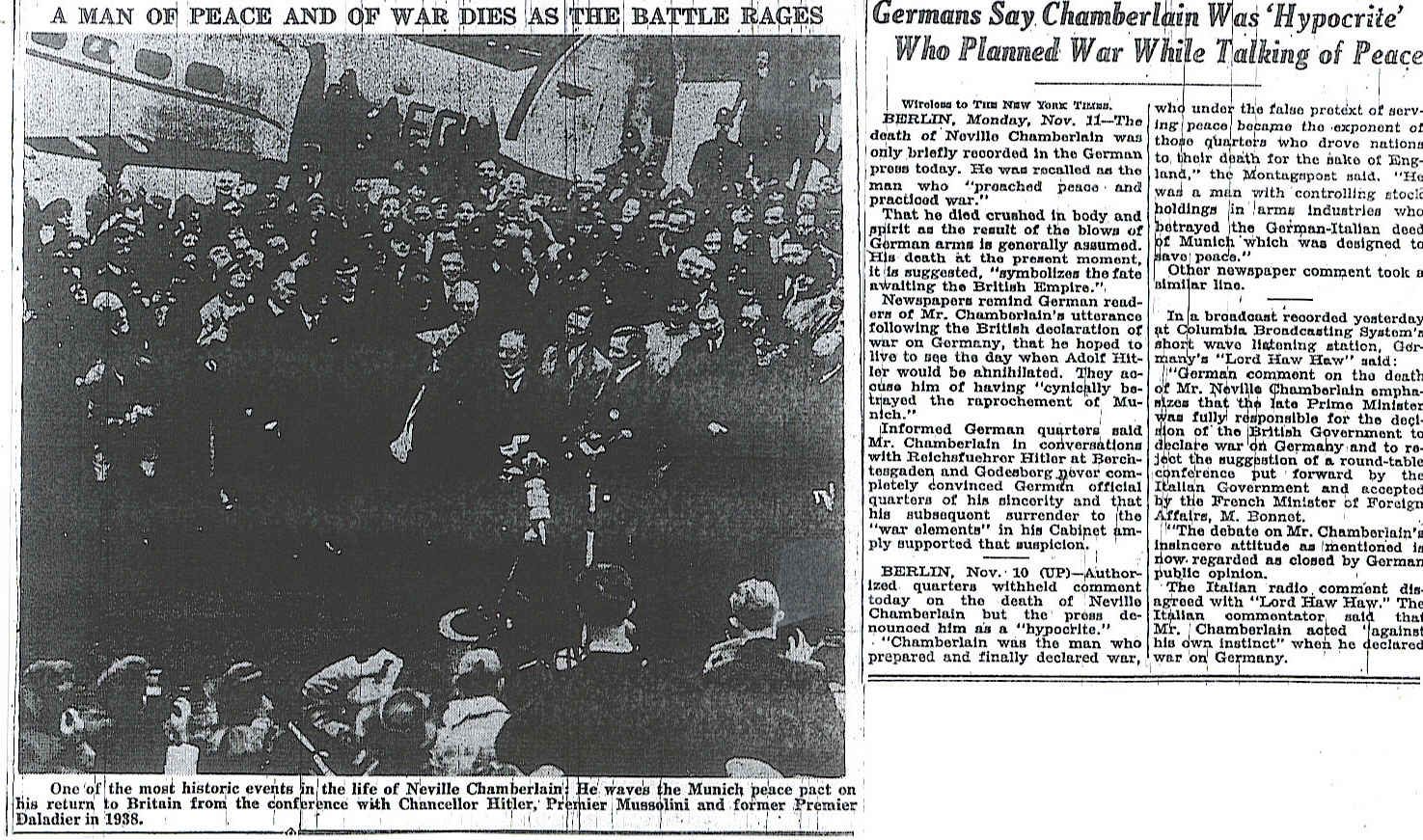
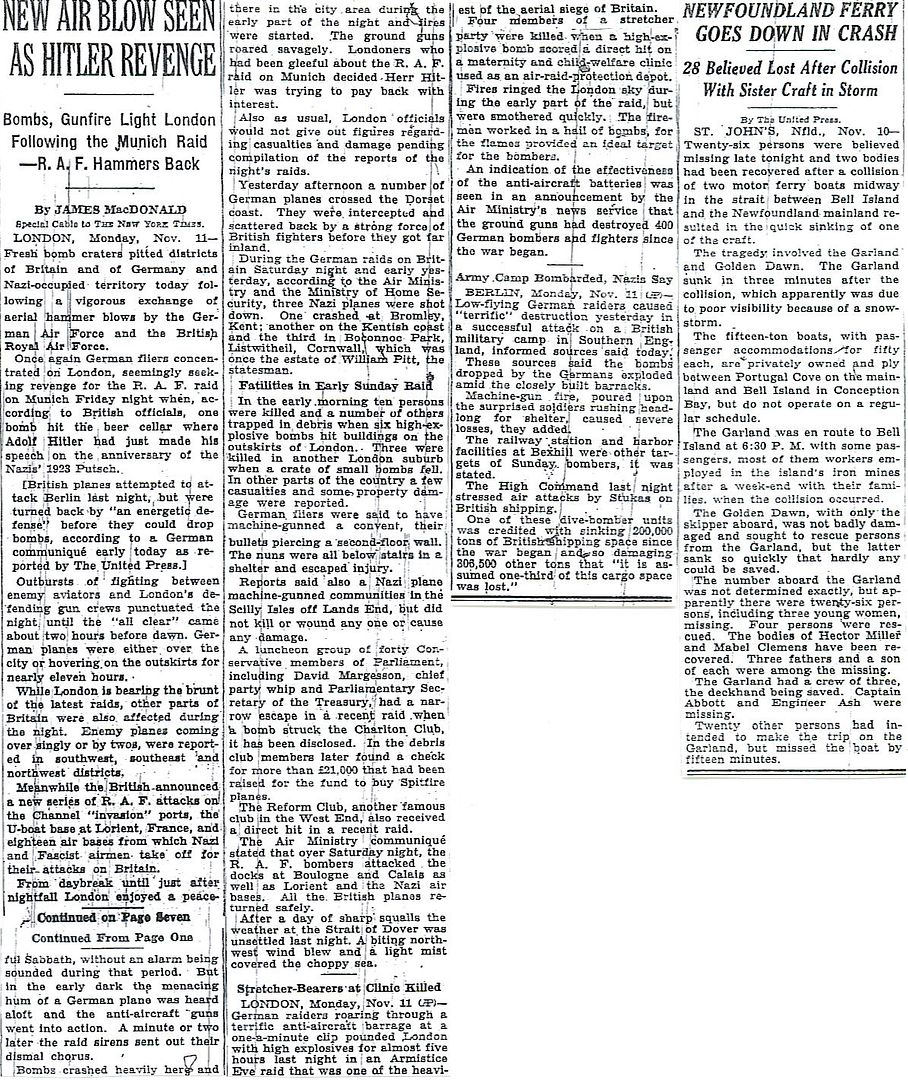
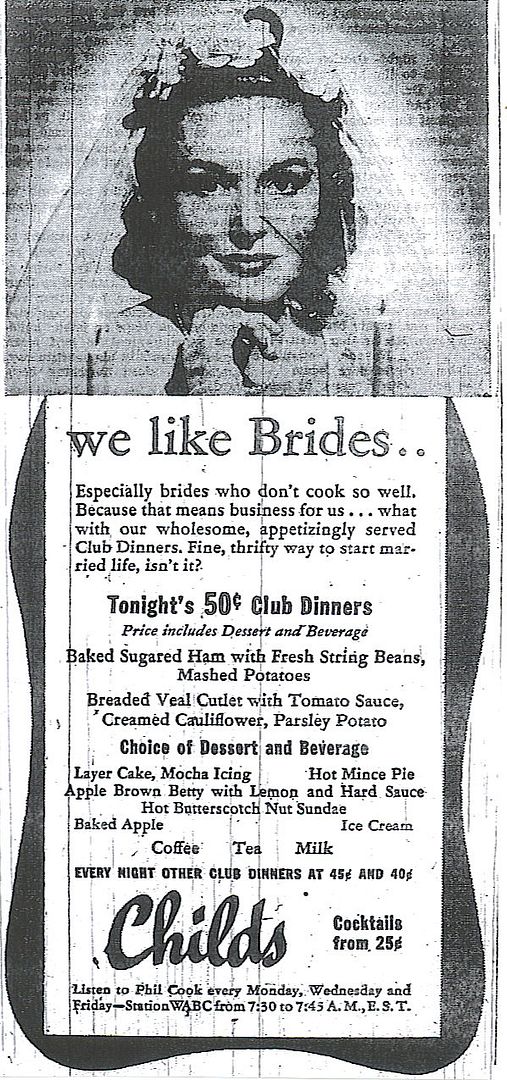
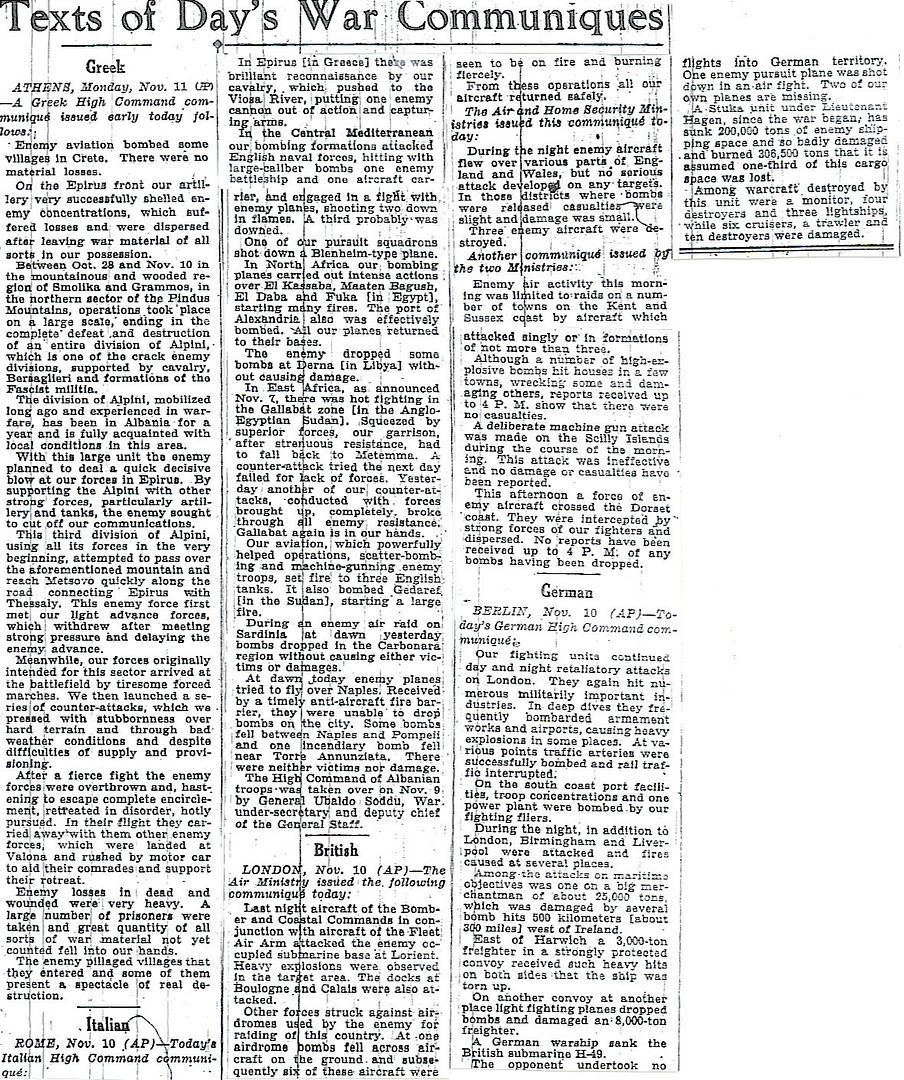
http://www.onwar.com/chrono/1940/nov40/f11nov40.htm
British attack Taranto
Monday, November 11, 1940 www.onwar.com
In the Mediterranean... The British Mediterranean Fleet attacks the Italian base at Taranto. During the night 21 Swordfish aircraft attack in two waves and gain three torpedo hits on the brand new battleship Littorio and one each on Caio Duilio and Conte di Cavour. Two other ships are damaged. The aircraft have come from the carrier Illustrious and only two are lost. This brilliant attack will certainly be studied by other navies and the potential for such an attack on an enemy fleet in harbor is clear to the Japanese.
Over Britain... In a postscript to the main actions a force of Italian bombers, protected by biplane fighters, is sent to attack Harwich. They are intercepted and lose six planes for no loss to the RAF. The Italians make other attacks, mostly by night, on east-coast ports during the next nine weeks.
http://homepage.ntlworld.com/andrew.etherington/month/thismonth/11.htm
November 11th, 1940
UNITED KINGDOM: RAF Fighter Command: Hurricanes of 46, 249 and 257 Squadrons intercept the only raid in strength by the Italian Air Force. Hurricanes shot down seven out of ten Fiat B.R. 20 bombers and four out of the 40 Fiat C.R. 42 fighters which escorted them toward the target of Great Yarmouth. No Hurricanes were lost.
First five Cant Z.1007bis reconnaissance aircraft escorted by 24 G.50bis fighters, followed by 10 Br.20 bombers, escorted by 40 CR.42 fighters.
Another day operation of the Italian Corpo Aereo Italiano, today, had different results from previous missions in October, three of the ten Br.20s of 43 St. were shot down by RAF fighters and three more being so damaged to be forced to effect crash-landings in Belgium. The RAF also shot down three C.R.42 biplane fighters. One of the B.R.20s had a crew of six, all wearing helmets and carrying bayonets. (Jack McKillop and Ferdinando d’Amico)
RAF Coastal Command: Seven Lockheed Hudson Mk. IIIs arrive at RAF Aldergrove, Northern Ireland, having flown direct from Gander, Newfoundland, in 10.5 hours. This marks the beginning of Hudson deliveries by air when all Hudson’s are flown across the Atlantic. They left in the early hours of Sunday morning flown by BOAC civilian air crews under the command of Captain D. Bennett.
RAF Bomber Command: 2 Group: Blenheims of 82 Squadron are sent to bomb Hamm, Soest, Osnabruck and Le Havre. Weather was very bad and only secondary targets were bombed, including Duisburg’s docks and the railway at Dortmund. Two aircraft failed to bomb and two crashed into the sea upon return. 2 aircrew were killed in the crashes.
FRANCE: Paris: German guards violently break up a patriotic demonstration by students at the Arc de Triomphe.
VICHY FRANCE: Jean Moulin, the uncooperative prefect of the Eure-et-Loir district is sacked by the authorities.
GERMANY: Dachau: 55 Polish intellectuals are executed in the camp’s first official mass execution.
U-159 laid down. (Dave Shirlaw)
MEDITERRANEAN SEA: ‘Operation Judgement’ - FAA attack on Taranto.
From Alexandria, Admiral Cunningham, with Malaya, Ramillies, Valiant and Warspite, carrier Illustrious, cruisers and destroyers, sails to cover convoys to Crete and Malta. HMS Eagle has to be left behind because of defects caused by earlier bombing. Force H, in a separate operation called ‘Coat’, supports the passage of battleship Barham, two cruisers and three destroyers through from the west to reinforce the Mediterranean Fleet. Troops are also carried to Malta at this time from Gibraltar.
Mediterranean Fleet meets its new members and covers the return of an empty ship convoy from Malta. On the 11th a cruiser force is detached for what turns out to be a successful attack on Italian shipping in the Strait of Otranto. HMS Illustrious meanwhile, escorted by cruisers and destroyers , heads for a position 170 miles to the southeast of Taranto. All six battleships of the Italian Navy are at anchor there.
That night Illustrious launches two waves of Swordfish, some of which belong to HMS Eagle. Under the command of Lt-Cdrs K. Williamson, and J.W. Halle, the total of no more than 20 aircraft of 813, 815, 819 and 824 Squadrons hit ‘Conte di Cavour’ and ‘Caio Diulio’ with one torpedo each and the brand new ‘Littorio’ with three. All three battleships sink at their moorings and ‘Cavour’ is never recommissioned, all for the loss of just two Swordfish.
NORTH AFRICA: Telegram from Churchill to Wavell:
I am very sorry that European events have forced me to complicate [your plans for Operation Compass]. Unremitting efforts will be made to remount your Air Force on latest machines at the earliest moment.
INDIAN OCEAN: German Merchant raider Atlantis claims 13th victim:
AUTOMEDON (1) was built in 1922 by Palmer’s Shipbuilding and Iron Co. at Jarrow with a tonnage of 7628grt, a length of 459ft 4in, a beam of 58ft 4in and a service speed of 14 knots. Sister of the Eumaeus she was built for the Ocean Steam Navigation Co.
When sailing between the Nicobar Islands and Ceylon the German armed merchant cruise Atlantis under the command of Kapitan Bernhard Rogge was spotted some 18 miles distance in a sea that was like glass. The two ships converged and when some 4600 yards apart the Atlantis swung to starboard, cleared for action and fired a warning shot. Immediately, the Automedon began to radio for assistance sending ‘RRR Automedon 0416N’ before the transmission was jammed and the Atlantis opened fire. The Atlantis was an experienced AMC and her gunfire extremely accurate. Her first shells demolished the bridge killing everybody there including her master, Capt. W. B. Ewan.
Three further salvoes scored eleven hits before the Atlantis ceased firing. The Automedon was still steaming at full speed and a man on board attempted to reach the stern gun to return fire. Three more salvoes hit the ship killing the gunner and stopping the ship. A boarding party from the Atlantis found a complete shambles with all the ships paper destroyed with the exception of those in the safe.
Examination of the holds revealed a cargo worth millions to the Allied war effort. Bound for Penang, Singapore, Hong Kong and Shanghai she was carrying aircraft , cars, machinery spares, bicycles, microscopes, service uniforms, steel and copper sheets, cameras, sewing machines as well as beer , whisky cigarettes and food supplies. There were also 120 mail bags. Rogge was concerned about the situation as both ships were stationary in a relatively busy shipping lane and another ship observing the scene would quickly guess what was happening and send a radio message before any action could be taken by the Atlantis. He therefore set a time limit of 3 hours during which time 31 British and 56 Chinese crew members, 3 passengers including a woman, their possessions, all the frozen meat and food together with the ship’s papers and the mail bags.
The British crew members were appreciative of Rogge’s gesture regarding possessions and assisted with the transfer of food but nothing else. They did, however, indicate where 550 cases of whisky were stored in the No.3 hold as well as helping to locate 2.5 million Chesterfield cigarettes. Among the 56 Chinese crew members were twenty or so who had been picked up from Lawther and Latter’s Anglo-Saxon which had been sunk earlier in the North Atlantic. They were on their way home to Hong Kong and Rogge was impressed by their phlegmatic stoicism.
As the stores were being loaded the safe was forced and the contents extracted. Because the bridge party were killed at the onset of the action the secret documents could not be destroyed. Amongst the papers were Admiralty Sailing Instructions, the Merchant Navy Code and Deciphering Tables 7, 8 and 9. To Rogge’s further astonishment, when two mail bags marked ‘ Safe Hand, British Master Only’ were opened, he found mail for the Commander-in-Chief, Far East which included Cabinet papers suggesting a defence of the Far East and a review of the European situation at the time. He also found detailed maps of minefields, new fleet cipher tables plus a number of coded documents. The contents of the two mail bags was so comprehensive that the Japanese later believed them to be fakes, put on board a British merchant ship in order to mislead the enemy.
Rogge then thought that he could tow the Automedon out of the shipping lanes but his engineers reported that the steering gear had been totally wrecked so the concept had to be abandoned.
Consequently, time bombs were placed aboard the Automedon and at 15.07 hours she became the thirteenth victim of the Atlantis as she sank by the stern. The survivors eventually reach Bordeaux in the captured Norwegian tanker STORSTAD. (Denis Peck)
CANADA: Oiler HMCS Sunbeam commissioned. Bunker Vessel, 589/11, ex-D.M. Hopper Barge No.4, ex-MandF Hopper Barge No.4, ex-Foremost 19, arrived Canada circa 1920, #132590, Purchased. Sunbeam’s Log - Built Port Glasgow, NS, Launched 1911, Yard #90, converted at Marine Industries Ltd, Sorel, Province of Quebec, hull Log - jn - 89, 589 tons, 178x33.5x12ft, 6kts, crew 2/27. Post WW.II, sold 1947, 1949 renamed Oakbranch, 1971 broken up. (MandF=Ministry of Marine and Fisheries, and D.M.=Dept of Marine). (Dave Shirlaw)
U.S.A.: Time Magazine reports on the first Draft selection of October 1940.
Secretary of War Henry Lewis Stimson, 73, stepped to the jar [same one used to pull draft numbers in 1917]. Fragile, twittery Lt. Colonel (retired) Charles R. Morris, who blindfolded Newton D. Baker for the first draft drawings of WWI, did the same for Mr. Stimson (with a bandage made from the cover of a chair in Independence Hall, sanitized with a sheet of Kleenex). Secretary Stimson gingerly put his left hand in the jar, took the first capsule he touched, handed it to Mr. Roosevelt. The President, old-stager that he was, glanced at the newsreel and radio men, got their nod before he intoned: “The first number is one-—five-—eight.” Registration serial number 158, held by some 6,175 registrants throughout the US, thus became draft order No. 1. In the crowded auditorium, Mrs. Mildred C. Bell gasped: 158 was her 21-year-old son Harry’s number. A friend sitting beside her squawked with excitement, bringing newsmen, radio announcers, and temporary fame upon the belles and Harry’s fiancé. (W Rinaman)
Minesweeper USS Raven commissioned.
Destroyer USS Ludlow launched. (Dave Shirlaw)
http://worldwar2daybyday.blogspot.com/
Day 438 November 11, 1940
Operation Judgement. At 11 PM, 21 Fairey Swordfish (11 with torpedoes and 10 carrying bombs) attack the Italian fleet at Taranto, taking off from British carrier HMS Illustrious escorted by 4 cruisers and 4 destroyers 170 miles Southeast. 6 Italian battleships and 3 cruisers lie at anchor in the outer harbour (Mar Grande). Torpedoes sink 1 battleship Conte di Cavour and damage 2 others, Littorio and Caio Duilio. 2 cruisers, 21 destroyers and 16 submarines rest in the smaller inner harbour (Mar Piccolo), protected from torpedoes. However, bombing of the inner harbour is ineffective. 2 Swordfish are shot down (1 crew of 2 killed, 1 crew of 2 taken prisoner). The remaining 19 Swordfish return safely to HMS Illustrious by 2.30 AM next morning.
In a daytime raid, 10 Corpo Aereo Italiano Fiat BR.20M bombers attack Harwich, England, escorted from bases in Belgium by 42 Fiat CR.42 biplane fighters (other fighters including German Bf109s abandon their escort duties due to bad weather). RAF Hurricanes from 257, 46, and 17 Squadrons intercept them over the Thames Estuary, shooting down 3 BR.20Ms & 3 CR.42s and badly damaging 2 more BR.20Ms (no Hurricanes lost). Winston Churchill quips “They might have found better employment defending the fleet at Taranto.”
Destroyer HMS Vega hits a mine and is badly damaged 5 miles North of Westgate-on-Sea, Kent, while escorting a convoy in the Thames Estuary. HMS Vega will be towed to Sheerness for repairs, completed November 14 1942. Minesweeping trawler HMT Stella Orion hits a mine and sinks in the Thames Estuary (no casualties). 200 miles Northwest of Ireland, U-103 is depth charged by British corvette HMS Rhododendron but U-103 escapes with no damage.
In the Bay of Bengal, British SS Automedon radios a “Raider Attack” signal when ordered to stop by German armed merchant cruiser Atlantis which then shells her to a standstill (7 crew and 1 gunner killed). 87 people, including 20 survivors rescued from the sinking of British freighter Anglo-Saxon, are taken prisoner. Atlantis captures top-secret Royal Navy documents including fleet orders, details of Naval and Royal Air Force deployment in the Far East, port defense layouts and Merchant Navy decoding tables and cipher pages (plus essential provisions such as whiskey, beer, cigarettes, fresh and frozen food).
The documents related to the Far East defense are turned over to the Japanese by Rogge. They prove extremely helpful to the Japanese when they attack Malaya.
One thing can be said - his name became synonyms with the word appeasement
Littorio takes three torpedoes, but is repaired. Conte de Cavour takes just one and is a total loss.
The difference? In 1940, there were battleships and there were dreadnoughts. Littorio was a new battleship, with better anti-torpedo armor belts. Cavour and Caio Duilo were WW1 era dreadnoughts. While other navies got around to modernizing their dreadnoughts with armor belts, which you can see in photos of all the British QE and Revenge class, as well as the American ships at Pearl Harbor, the Italians hadn’t quite kept up.
The British operation against the Italians which I’m sure we will read about tomorrow will really cause many to take pause. Admiral Richardson and Stark will discuss this attack later in the month and I will post the interchange as it goes since it is pretty interesting.
I guess there’s a reason why there is no such thing as a “Neville Chamberlain Action Figure”. RIP Neville.
It's not news until the censor says it's news. Censor says, day after tomorrow.
Darn censors. A posting I have for tomorrow does make a mention of this attack. I hope I don’t get in trouble with these guys.
I guess we have to knock off that crystal ball stuff.
OK, being on topic:
Its interesting to see how things are playing out in Vichy’s overseas colonies and with the French Fleet.
In the first war, Germany had overseas colonies that were ripe for the picking. As a continental power, blockaded by the maritime power, she could not defend her colonial assets. It didn’t really matter since they were not vital to her war effort.
Now, in the new war, a slightly different scenario is playing out the same way. While Germany does not directly have overseas possessions, her puppet government in Vichy does. Vichy is unable to protect it’s overseas possessions and the British are using their Free French proxies to pry them away from the Axis. (With the interesting exception of French Indo-China, where another maritime Axis power is prying them away from the French).
I think the loss to Vichy of the African colonies is more important to the outcome of this war than it was in the last war. The Germans needed some sort of security to the south and west. But they aren’t finding it in their allies (Italy), puppets (Vichy), or other states they thought were friendly (Spain).
It seems that most of these “allies” at some level, hate or at least resent, the Germans. And probably strongly dislike each other, and don’t really have a bone to pick with Britain.
While the Allied coalition of the United States, Britain, the USSR, Free France and China will have their areas of friction, it’s nothing like what you see on the other side of the line.
I think it also shows the real lack of co-ordination between the Axis powers. Even though Japan was part of the Axis, at no time is there any real effort now (or in the future) to link up. The Italian attack on Greece really took away prospect of Franco joining the Axis since it was a sign to him the Germany could not control its allies who were eager for starting new battles. Franco’s Spain is only a bit more than a year out of finishing its own conflict and does not have a deep interest in getting pulled into someone else fight. Italy is running amok and being incompetent in the act and like you said, Vichy has very mixed support in its colonial areas. The Allies will have their problems, but at least they all worked towards a common goal, something that the Axis just never did.
Still too soon. I should have said the day after the day after tomorrow. 11/14.
"The Allies will have their problems, but at least they all worked towards a common goal, something that the Axis just never did."
Not certain if this point has been made here before, but it bears keeping in mind:
Here is a link for historical GDPs.
The point of the war, then, was: which side could better manage and increase its resources for the war effort?
Axis powers had the advantages of a common ideology and supposedly better "top down" resource allocations.
But they never acted with anything like the concerted efforts of the Allies.
There were never, for example, strategy meetings of Hitler, Mussolini and Tojo comparable to those of Roosevelt, Churchill and Stalin.
End result was, the Axis did not make effective use of their combined resources, and thus allowed both the US and USSR to operate from "interior lines" -- attacking & defeating them piecemeal.
And what's most curious about this is that each Axis power considered itself to be a great military force, easily able to take on and defeat the rotten & soft western democracies and Soviet communist slaves.
But the Allies' metal proved more resilient than expected, and the Axis more, well, brittle.
Measuring war-making potential is a fairly imprecise art, but I think it is more complex than just adding up GDP and populations. But it has been tried. Paul Kennedy did an analysis of World War II war-making potential in “The Rise and Fall of the Great Powers: Economic Change and Military Conflict from 1500 to 2000.” His potentials were listed as pie slices; what each country’s percentage of world war making potential was. The formula, as I recall, was to include population, industrial base, access to raw materials & trade, and financial strength.
His numbers didn’t quite add up the way yours did. Germany, Britain and the USSR were all comparable with about 12-15% of the world’s war making capacity, making each of them relatively even with the other two. Germany’s main allies, Japan and Italy, were each well below 10%. It was the United States that threw the scales solidly to the allies with about 40% of the world’s capacity. I’m just relating these numbers from memory, so don’t hold me to them as exact figures.
Where I would disagree with your assessment of war-making capacity is that you include population and GDP of “conquered” territories. As we can see with Vichy France, and what is happening with the French colonies, France’s war making potential in April 1940 does not transfer to the Germans at 100% in November 1940. Large parts of the French army are still being held as POWs. The British blockade has cut France off from her overseas resources. French industry is now idle. And the French people do not welcome their new German masters with open arms. I agree that the Germans could have made much better use of France’s industrial base. The French motor industry was the best developed in Europe, and France could have been turned into a giant truck/rail factory for Germany. The French army of 1940 was largely motorized, and the Germans could have motorized their own army with the French resources. Don’t ask the French to make weapons for le Boche; they might balk at that. But trucks? What harm can they do?
The real failure of the Germans was a failure to have an Axis “Lend-Lease” program. Their inability to adequately equip their own forces meant that there was nothing to spare for their allies. If the Germans had been able to mass produce their very good high-velocity 75mm anti-tank gun in such quantities to equip the Romanian armies flanking Stalingrad, there is every reason to believe the Romanians could have held off Operation Uranus. As it was, each Romanian division had cast-off 37mm anti-tank guns, which were totally useless against T-34. And each Romanian division only had 12, yes TWELVE, of them. Contrast this with American lend-lease, and how well we were able to not only equip our own forces, but to support the rest of the world.
So while I agree that the Axis could have made better use of what they had, my point is that they were never going to make subjugated peoples who hated them wholeheartedly work fight for them, much less fight for them. And they were never going to match the war-making capacity of the allies once that alliance included the United States.
That's my point, of course.
I'm saying, by 1942 the Axis powers, all included, had potential to roughly match the Allies -- in economic capacity, if not raw materials.
This would include France and other conquered territories -- had those resources been fully organized & used.
The Germans' inability to manage & motivate their subjects & allies was, naturally, part and parcel of their Nazi ideology, and no-doubt, inherent racism.
But it doesn' mean those resources weren't there to be organized.
And indeed, by war's end, Albert Speer had much better organized Germany's industrial capacities.
But did even Speer ever make full use of the Italians, French, Dutch, Belgians, Norwegians, Spanish, etc. capabilities?
I don't know for certain, but much doubt it.
“The Germans’ inability to manage & motivate their subjects & allies was, naturally, part and parcel of their Nazi ideology, and no-doubt, inherent racism.”
And there you go. That’s the real crux of the counter-factual alternative scenarios in WW2. You can’t do a scenario that requires the Germans to not be “German” or having Hitler not be Hitler. The outcome is no different than the “what if Napoleon had a squadron of Apache helicopters at Waterloo?” It couldn’t happen, so it’s not a valid hypothetical.
I agree with you that within the context of the Germans being “German” and Nazi Germans at that, they could have made better use of their resources. Believe it or not, so could we, but that would have involved an earlier mobilization for a war effort, but this means the Americans would not have been “American.” But the point remains that even though I think the Germans could have done better, they were never going to match the war potential of the United States/British Empire/USSR combine.
We haven’t even touched on the Japanese. I’ve posted before that the Japanese had no business taking on the United States of America. Even though their territorial gains in the first six months of the war were quite impressive, and they entered the war with a first class navy and air force, Japan’s problem was that her industrial potential was already maxed out. Her merchant fleet was too small to support the raw material demands of industry in the home islands and simultaneously transport war material to the far-flung reaches of her Empire. In addition, her shipbuilding industry was not capable of making up the difference. You ought to see the naval and merchant marine construction figures during the war. Japan pretty much had to fight the war with what she had built before 1941. American naval construction was enormous, while at the same time we built 50,000,000 tons of merchant shipping.
The course of Japan’s war was pretty much never in doubt.
Disclaimer: Opinions posted on Free Republic are those of the individual posters and do not necessarily represent the opinion of Free Republic or its management. All materials posted herein are protected by copyright law and the exemption for fair use of copyrighted works.